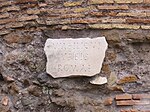Basilica Opimia
120s BC establishmentsAncient Roman building and structure stubsAncient basilicas in RomeRoman Forum
The Basilica Opimia was one of four Republican-era basilicas in the Roman Forum. The other two were the Basilica Aemilia, the Basilica Porcia, and the Basilica Sempronia. Of the three, only the Basilica Aemilia partially survives. It was built in 121 BC near the Temple of Concord and named after Lucius Opimius, who had financed its construction and that of the temple. When the Temple of Concord was enlarged under Tiberius the basilica had to be sacrificed and there is no record of its survival after that date.
Excerpt from the Wikipedia article Basilica Opimia (License: CC BY-SA 3.0, Authors).Basilica Opimia
Via dell'Arco di Settimio, Rome Municipio Roma I
Geographical coordinates (GPS) Address Nearby Places Show on map
Geographical coordinates (GPS)
| Latitude | Longitude |
|---|---|
| N 41.893 ° | E 12.4843 ° |
Address
Tempio della Concordia
Via dell'Arco di Settimio
00184 Rome, Municipio Roma I
Lazio, Italy
Open on Google Maps








